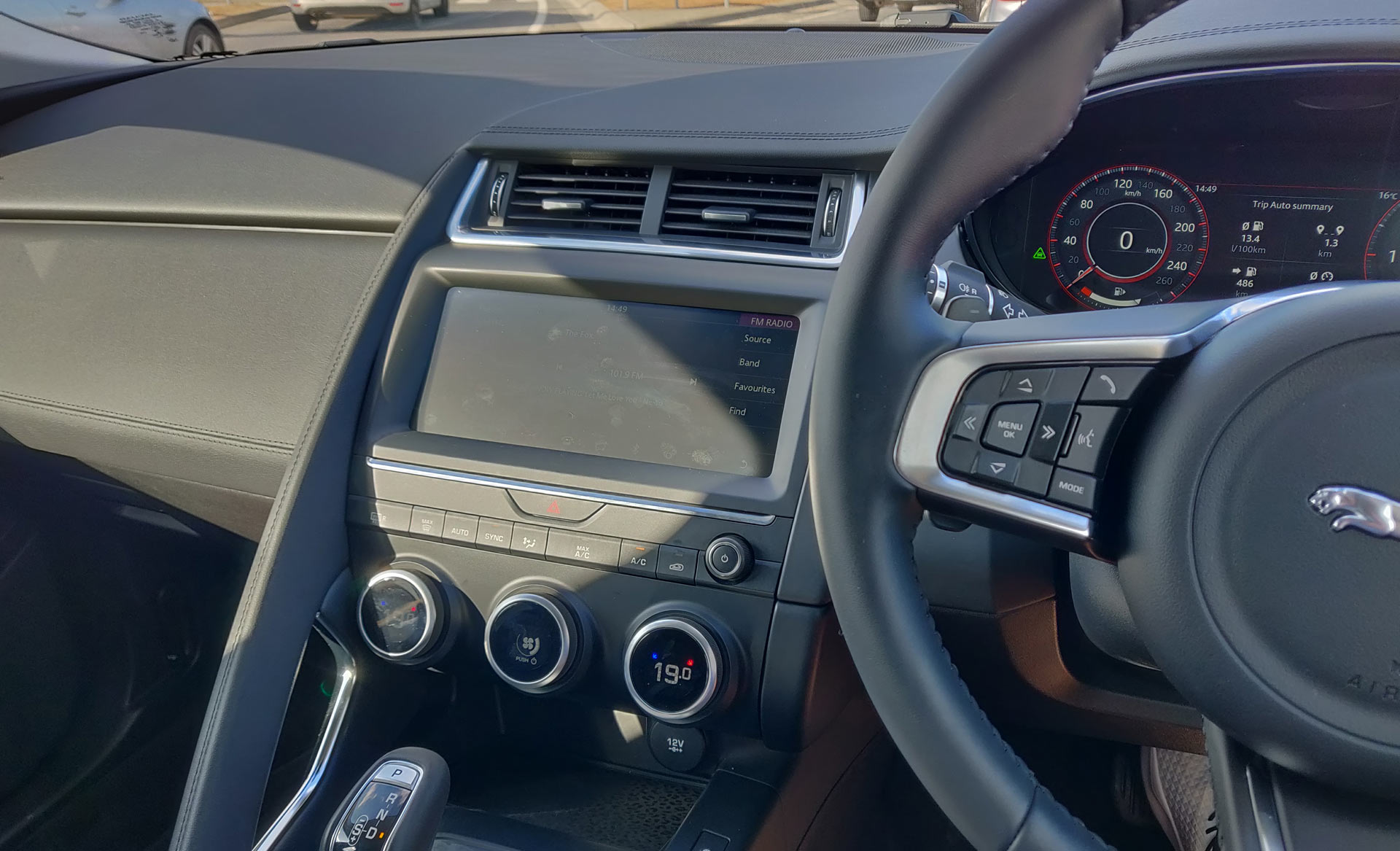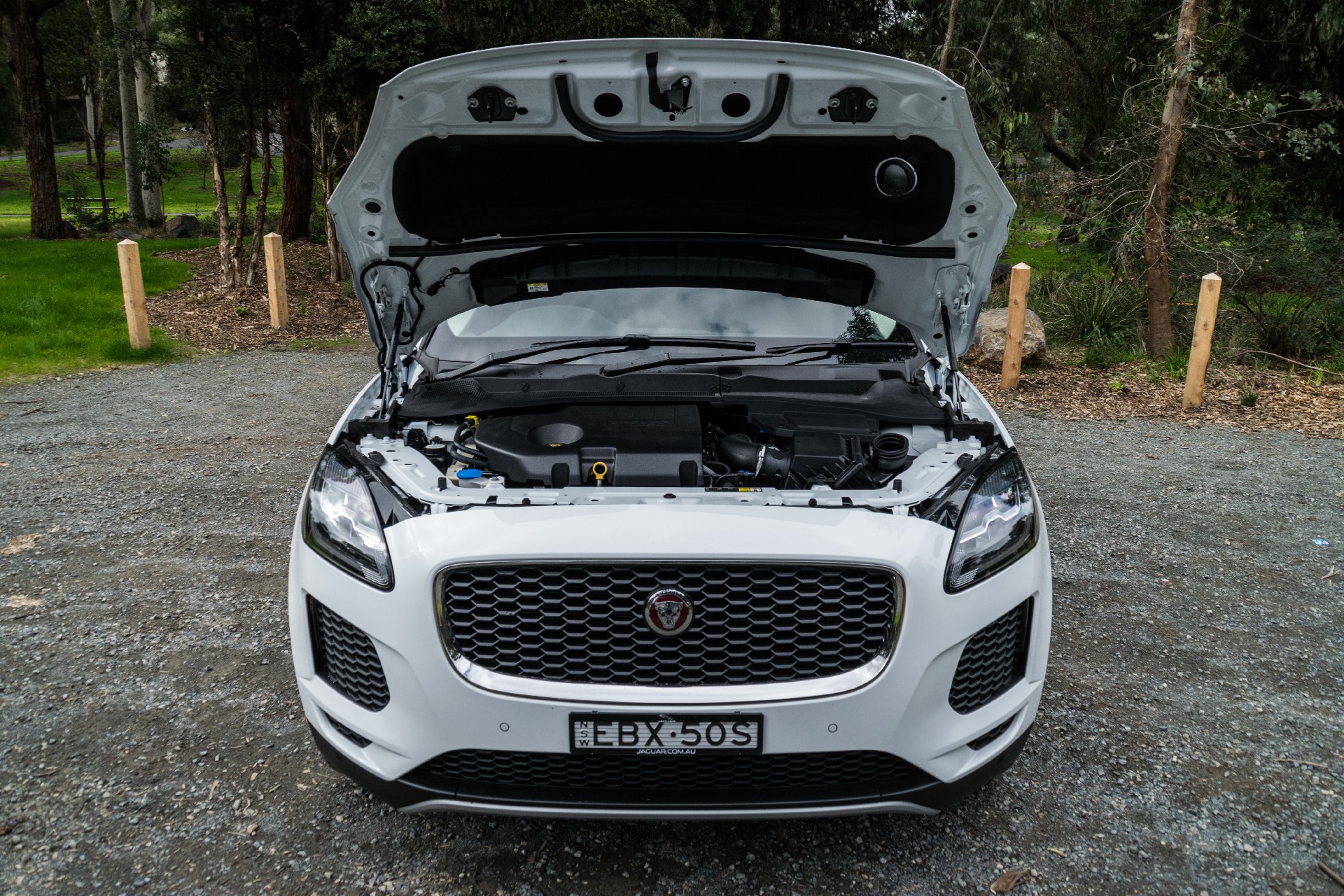If you were to line up most of the market’s premium compact SUVs, remove their badges and have non-car enthusiasts tell you the brand of each vehicle, we have an inkling many would struggle to identify one from the other.
This isn’t to say they all look alike. They don’t (at least not to our eyes), but do demonstrates how uninspiring the designs of most compact SUVs are. They don’t spark your imagination. They don’t make your palms start sweating and they don’t get your heart racing when stationary.
Thankfully, the Jaguar E-Pace is a little different.

Stylish, yes, but is there substance too?
The British carmaker’s first crack at a compact SUV has delivered what I believe is the best-looking vehicle in the segment. Not only does it look drastically different than any of its competitors, but it is easily identifiable as a Jaguar, even if you were to remove the badge. However, once you strip away the sexy skin you’ll be left with a vehicle which, while good, has a number of shortcomings.
Jaguar Australia handed us the keys to a 2019 E-Pace SE D240 in Fuji White for a week of testing. I deliberately organized to pick up the keys moments after I returned a Volvo XC40 Inscription to see how it would compare.

On paper, things read very well. Powering the E-Pace D240 is JLR’s 2.0-liter four-cylinder Ingenium diesel with an impressive 177 kW (240 hp) and 500 Nm (386 lb-ft) of torque. Those are promising figures especially for a diesel SUV of this size and result in snappy performance. The E-Pace pulls strong through all nine gears and even if you’re cruising on the highway in top gear, there’s still a respectable amount of torque under your right foot.
Options galore
The test car was a mid-range SE model, which slots between the S and the HSE. The SE comes standard with many different features such as a powered tailgate, grained leather seats, a Meridian 11-speaker sound system, navigation and a suite of driver assistance programs such as emergency braking, a rear-view camera, driver condition monitor, lane keep assist and autonomous parking.
Customers have an array of optional extras just the tick of a box away when configuring their perfect E-Pace. My test car was free of many of these extras such as the $2,160 fixed panoramic roof, $1,630 head-up display, $970 black contrast roof and $1,690 20-inch alloys. It did have some nice touches, such as the 19-inch five-spoke satin grey wheels, rear privacy glass, R-Dynamic branded leather steering wheel, black paddle shifters and interactive 12.3-inch configurable gauge cluster instead of the analog dials that come as standard.

An attractive cabin with flaws
The interior of the E-Pace is a mixed bag. In general, the SUV has a nice cabin layout and lots of soft leather components. There are memory seats, the aforementioned Meridian sound system (which is excellent), and the driving position is superb. Like other Jags, drivers are able to lower the seat so far down that they come close to the feeling of being in a sports car instead of an SUV. In addition, the steering wheel adjusts not just in the vertical plane, but it also has a long telescoping range, so if you want it near your chest, you can do it, but if you prefer a more relaxed driving position, you can have it pushed back towards the dashboard.
Also Read: Some Jaguar E-Pace SUVs Miss Key Infotainment Software – And There’s No Fix
Jaguar has also absolutely nailed the R-Dynamic steering wheel. It is perfectly sized and very soft to the touch, but the optional paddle shifters feel plasticky and cheap. I also wasn’t particularly fond of the steering wheel controls, finding them unnecessarily complicated and not all that nice to the touch.

If the sun’s out, you can’t use the screen
Jaguar has designed the infotainment system to sit in a neutral position, rather than tilting it towards the driver. That’s not a big deal; heaps of other cars are like that. What is a big deal, however, is the fact that the screen is tilted up at what must be a 20- to 25-degree angle towards the roof. This means that if you’re driving on a sunny day, the screen is hit with a huge amount of glare making it virtually impossible to see and interact with. With the panoramic moonroof, the glare would be even worse. The user interface also isn’t particularly user friendly and nowhere near as intuitive or fast as the one in the Volvo XC40.
Two other less-than-impressive parts of the E-Pace’s cabin is the shifter and the cup holder cover. The shifter gets the job done but feels cheap compared to other cars like this market like the XC40 and even Land Rover’s Discovery Sport with its rotary gear selector. The Jaguar also has an odd plastic cover that sits over the cupholders. This cover doesn’t fold or slide away – it simply lifts out, so if you want to use the cupholder, you have to store this cover somewhere. Dumb.
I wanted to like the E-Pace. I really did. As I jumped behind the wheel and drove the first few hundred meters away from where I had left the XC40, I felt the disappoint barrel me over like a rough wave in the ocean.
The steering of the E-Pace D240 has a surprising amount of weight to it but it feels vague, indirect, and inconsistent. Things do improve when you shift the car into ‘Dynamic’, as it sharpens everything up and makes the car more responsive. The brakes of the E-Pace are also a letdown. If you slowly apply pressure to the brakes to come to a stop, the Jaguar doesn’t brake smoothly, no matter how silky your brake application may be. I often found myself depressing the brake pedal about 30 per cent of its travel and the car would aggressively wipe off speed for a second or two before starting to slow at a pace more reflective of pedal pressure. You get used to it but it does get annoying as there are so many other cars on the market with more predictable brakes.

As mentioned, the E-Pace D240’s powertrain is good. The engine is very refined for a diesel and, at low revs, whisper-quiet. The nine-speed automatic transmission almost feels like a CVT at times because of the way it changes through the gears with so little fuss. When pushed, it’s hard not to be impressed with the briskness at which the D240 picks up speed, thanks mainly to that 500 Nm of torque. Jaguar claims a combined fuel consumption figure of 5.6 liters per 100 km (42 U.S. mpg), but even on long highway cruises I never saw that dip below 8.0 liters per 100 km (29.4 U.S. mpg).
Where the driving experience of the E-Pace falls down at slow speeds when you’re trying to be smooth and responsible, it shines when pushed. The SUV tips into corners in a way few competitors can match. The steering also feels better at speed when you grab the car by the scruff of the neck and if you do hit the brakes hard, they do respond well. Try to be dignified with your steering, throttle, and brake inputs, however, and the Jaguar feels at a level below its competitors. Our test car’s drivetrain also produced some worrying knocks and creaks when accelerating hard out of corners.

If you love the looks, you might forgive its blemishes
Coming away from my week with the E-Pace I was left unsatisfied. The car looks fantastic and for the most part, has a very nice interior. However, with prices starting locally from $68,010 AUD for a base D240 SE, it’s hard to recommend it over other alternatives, particular the XC40 which has more standard features and costs about $10,000 less in Australia. If you love the styling of the E-Pace, by all means, sign on that dotted line but know there are better vehicles in this class.
Car Scoops










Post A Comment: